Our bodies are built to adapt. How else would we ever develop the strength (mental and physical) to meet challenges or compete in sports, let alone recover from them to be stronger, more capable, more resilient than before? That means that our training can be hard. It should be hard at times. But what can you do when you have pain when you squat—especially given the all-too-common and frequently short-sighted advice to avoid all squatting? Here, David Cho, SFG I, Doctor of Physical Therapy, and CSCS shares three simple squat modifications to work around pain.
Preface: The following advice is NOT a suitable replacement for a hands-on assessment by a clinician. If you have pain, please consult a medical professional who understands YOUR goals and (hopefully) strength. Once cleared, an FMS-certified coach can help get you started.
It shouldn’t come as a shock to anyone that training can (and should) be hard at times. It’s important to push our boundaries intelligently especially when we train for events, i.e. an instructor certification strength tests, the snatch test, or the TSC.
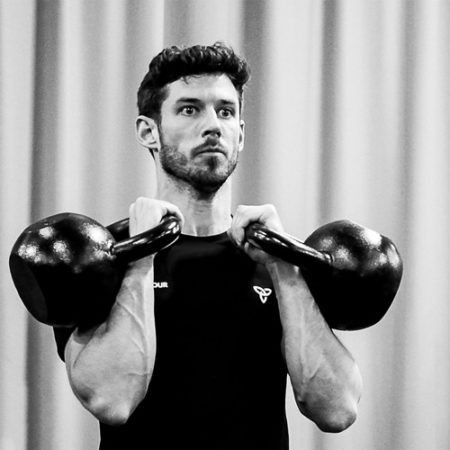
Now, what if we have pain? The typical reaction from many medical providers tends to be STOP. Why? They’re concerned about causing an actual injury. That’s good, right? The problem arises when STOP becomes “that movement you did is bad for X and you should never do that again,” and/or “you shouldn’t lift anything heavier than 10lb.” We’ve all heard it, and we know that in virtually all but the most extreme cases, it isn’t true. Avoidance of movement is simply not a long-term success strategy for most. Not moving, not training, and not doing anything are the wrong answer 99.7% of the time.
Ingrain that in your mind. Get it tattooed somewhere—I’m considering it.
But it Hurts When I Squat
Pain with squatting is a common occurrence in the performance field. Once structural damage or a required medical intervention is ruled out, we move on to rehab. Most programs will begin with manual therapy, isolated muscle strengthening, passive modalities (ice, heat, electrical stimulation, etc.), and other pain-reducing strategies. The problem comes when strength progressions are not implemented quickly enough. Rehab must be challenging to create positive change in the body. Current research has shown that our bodies require anywhere from 70-85% 1RM loads to strengthen tissues. This means our “training” weights can actually be our rehab.
Training and rehabilitation should not be considered completely separate. They are simply on different ends of the performance scale.
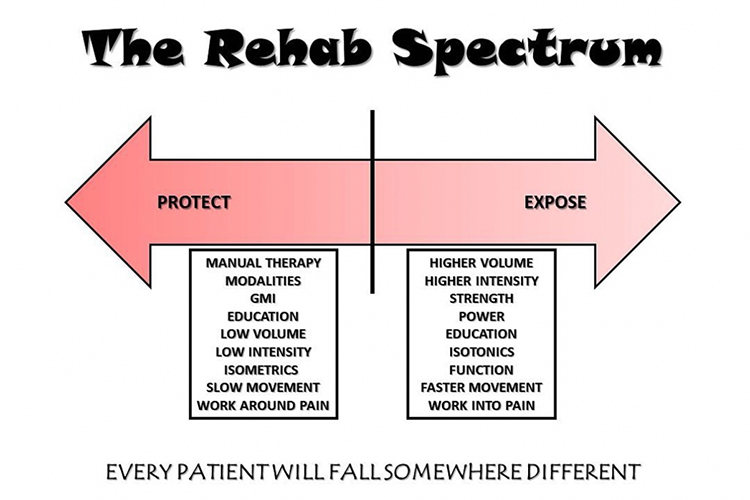
So How Do we Safely Squat with Pain?
It’s simple.
Find a way to perform a different variation of the squat. It can be as easy as using a lighter weight (No duh, right? But how many of us do this?) or doing lower volume. Here are some of my other favorite ways to modify movements:
- Tempo
- Range of Motion
- Body Position
(I
left out finding a proper instructor to assess technique and watch for movement
compensations that you likely don’t know about because this should go without
saying).
Tempo
Tempo refers to the speed of your movement phases in a particular repetition. Most (I could argue every) exercise has a concentric and eccentric phase. In a squat, the eccentric phase happens when you lower yourself towards the bottom: your muscles work to decelerate your descent. The concentric phase is the reverse: you accelerate or rise up from the bottom. Select a weight that doesn’t trigger a painful response (hint: it’s heavier than you might think and remember that tissues strengthen in response to load). For most people, I’ve found that an appropriate starting weight can be anywhere from 50-70% of their training max depending on the severity of their discomfort. Now make the concentric and eccentric portions last longer than normal. I typically stick with the 5-6 sec range. To further clarify, take 6 seconds to lower into a squat and then take 6 seconds to rise back to your starting position. There is a third type of muscle contraction to consider—the isometric—that happens between the eccentric and concentric phases (or vice versa). For the squat, it’s the hold (if you include one in your tempo) at the bottom, between going down and coming back up. Isometric exercises are such a terrific rehab tool that I’ll save discussing them for their own future article.
Range of Motion
Remember when we all judged people doing half squats? Well, there’s some value to them. I use them all the time with people who have knee pain during squats. Again, don’t forget the primary purpose of these modifications: it’s to reintroduce movement patterns and load them in a safe manner where they do not feel pain all the time. If that means having someone squat 70% of their 1RM to a high box, then great! Be patient. You’re still getting stronger and, more than likely, building a better base than you ever had before.
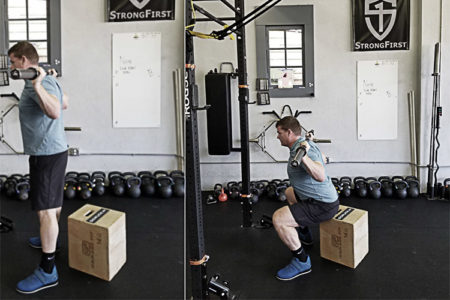
Body Position
So what if it hurts to do anything standing? Try seated variations. That hurts too? Try lying on our back or stomach. One of my favorite movements to recreate a squat is rocking. It’s very easy. Set yourself up on hands and knees. Keep the eyes looking forward and simply sink your hips back toward your heels.
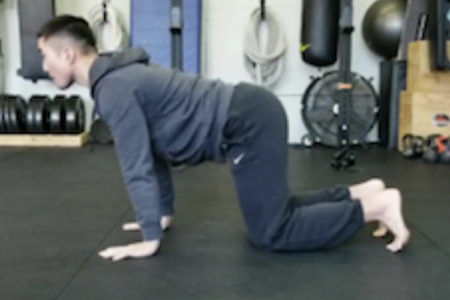
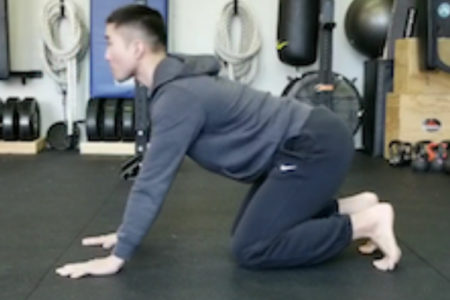
What does this look like? A squat! We can progress this position by simply placing a swiss ball against the wall and rocking into it.
As you might’ve already noticed, you can use all 3 modifications in conjunction and apply them to nearly any movement.
We can spend hours discussing many of the topics I’ve brought up in this article, but hopefully, I’ve given some actionable techniques that you can keep in your toolbox whenever needed. Please reach out to me if you have any questions.

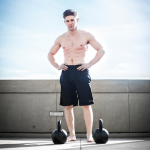
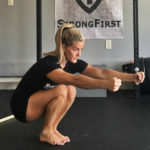



Thanks for the reminders. This is immediately applicable with a current client.
Thank you Eric. I like to keep things simple and effective.
I really don’t relate to these ‘strongmen’. Most of us are just trying to continue our lives without pain. There’s a tendancy in physio to only see the athlete. The rest of us feel like we’re your waste of time.
Jon,
I can relate. Growng up I was super skinny; parents never encouraged sport of any kind. However, I’m old enough (lucky enough)to have been a child before the advent of video games. Thus, I played outside, a lot, and that comes with it’s own consequences. I have an elbow that hurts often and doesn’t fully extend(broke when 7yrs old), a structurally length discrepancy with subsequent knee pain(meniscal) and both ankles were broken as a child resulting in regular pain and less than full range of motion today. None of these issues were properly addressed growing up so that’s just my body.
It sounds like you’ve had some less than great experiences with “physio’s”. Keep looking but first be clear on what you want AND what is realistic. What you have experienced my be indicative of a culture but it can’t be extrapolated to “all”. Look, I discovered strength training in my mid 40s and haven’t looked back. I’m nearly 50 and have completed numerous strength events, several marathons and a few ultramarathons. I have pledged to myself (for my health) that I’m will NEVER stop lifting (as long as I’m able). The benefits are simply too great to ignore. That said, I have had to adjust my training accordingly for MY body. I am an SFG Certified Instructor going on 3years now. My suggestion is that you find a coach that can empathize AND has the requisite skill/ability to adjust your training according to the needs of YOUR body. They’re out there and those types of trainers get excited to use their abilities to help people. Don’t settle for less!
Awesome testimonial Eric!
Hey Jon,
I apologize for the delay in responding. If anyone (clinician or not) has made you feel as if you’re wasting their time, they probably aren’t the right person to be your resource. Before I say anything else, please remember that strength is for everyone and it is never a weakness. The tools I discussed in the article were supposed to be applicable to ANYONE no matter what their situation may be.
Squatting isn’t only for athletes. The squat is a movement. If you look at the picture of the gentleman box squatting with a bar, we can simply replace that with an individual (without the bar) sitting onto a chair.
I hope you’ll find a great clinician and/or instructor to assist you towards your goals. I’d suggest using our “Find an Instructor” page as a start. If you’re ever in Atlanta, please message me! I’d be happy to help.
Hi my name is TJ, I was wondering if you have any answers for my pain? Every since I started doing squats right above my niece I have a pain not only just doing squats even when I go to sat down on the toilet. Every time I go to gym on a leg day to do squats it is so uncomfortable to bear it I end up not finishing it.
Hey TJ,
It would be irresponsible of me to try and provide advice over the internet in regards to your pain. I highly recommend finding a clinician that can provide a proper assessment.
In the meantime, I would suggest performing movements that do not make your pain worse.
This is informative and applicable to my practice. Thanks David!
Thanks brother! I appreciate you taking the time to read the article.